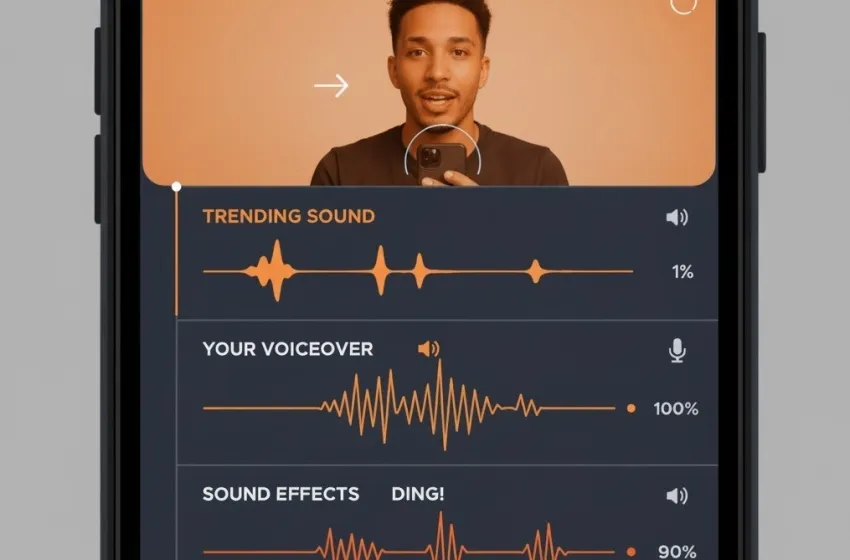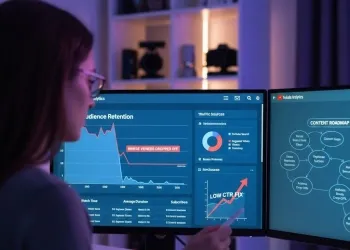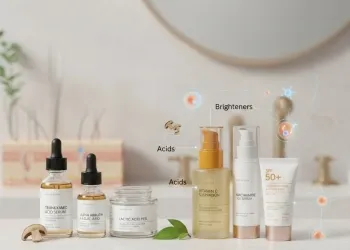Master the audio layering strategy using a low-volume trending sound, original voiceover, and sound effects.
In the fast-paced, highly competitive world of short-form video platforms like TikTok and Instagram Reels, getting your content noticed by the algorithm is the ultimate goal. Creators often focus on visuals, captions, and hashtags, but the secret weapon for massive organic reach lies in a sophisticated technique: audio layering. This isn't just about adding music; it's a strategic, multi-layered approach to audio design that speaks directly to the platform's detection systems, earning your video an unfair advantage—a true FYP hack.
The algorithm doesn't just judge the watch time or engagement rate of your video; it actively listens to the audio tracks. By intelligently combining multiple audio elements, creators can fulfill both the algorithm's requirements (using a recognizable track for a reach boost) and the audience's desire (providing unique, high-quality content).
Understanding the Algorithmic Power of Sound
Short-form video algorithms are constantly monitoring which pieces of music and audio are experiencing viral uptake. When a user creates a video using a currently trending sound, the platform's algorithm tags that content as relevant to the current wave of popularity. This significantly increases the video's potential distribution, as the algorithm wants to show users more of the sound trends they are already engaging with.
However, simply uploading a video that's just a trending sound and a visual provides little value. The key to long-term success and building a genuine audience is originality, which is why the three-layer strategy is essential. It allows you to harness the algorithm's desire for the familiar while satisfying the viewer's need for the fresh.
The Three-Layer Audio Layering Strategy
The most effective strategy for maximizing algorithmic reach involves the simultaneous use of three distinct audio tracks. This technique is known as audio layering and is a non-negotiable step for creators aiming for virality.
Layer 1: The Low-Volume Trending Sound (The Algorithm Bait)
This is the most critical layer for algorithmic success. You must select a piece of music or audio that is currently a trending sound—one that is spiking in usage across the platform.
- Action: Add this audio track as the base layer of your video.
- Crucial Step: Reduce the volume of the trending sound significantly. It should be set to a low, almost background level, typically between 1% and 5% of the maximum volume. The human ear should barely perceive it, but the algorithm will register its unique audio fingerprint instantly.
- Purpose: The sole purpose of this layer is to trick the algorithm. By recognizing the sound, the platform classifies your video under the trending audio's category, granting it the initial distribution boost given to all content using that sound. It's the essential component of the FYP hack.
Layer 2: Your Original Voiceover (The Value Provider)
This is the layer that provides your content's unique value, commentary, and personality. It’s what keeps the audience engaged after the algorithm has delivered the video to them.
- Action: Record your own original voiceover directly through the platform's recording tools or upload a pre-recorded track. This could be a reaction, a tutorial narration, a personal story, or a unique piece of commentary related to the video's visuals.
- Crucial Step: This layer must be the primary audio element, set at 90% to 100% volume. It needs to be crystal clear and easy to understand, completely dominating the low-volume background track.
- Purpose: The original voiceover elevates your content beyond simple lip-syncing or background music. It builds your personal brand, establishes you as a thought leader or entertainer, and is crucial for achieving high watch time and completion rates—the secondary metric the algorithm uses for sustained reach.
Layer 3: Strategic Sound Effects (The Attention Grabber)
The final layer is used to punctuate key moments, emphasize emotional shifts, and increase the overall dynamic quality of your video, preventing viewer boredom.
- Action: Integrate well-chosen sound effects at strategic points. Popular effects include whooshes, booms, crescendos, ding! sounds, or comical noises (like cricket chirps or record scratches) to emphasize a joke or a reveal.
- Crucial Step: Sound effects should be used sparingly but effectively, timed perfectly with on-screen actions or punchlines. Their volume should be high (80%-100%) for maximum impact.
- Purpose: These short bursts of audio are phenomenal tools to grab and reset a viewer's attention. In a quick-scroll environment, a sudden sound effect can break a user's scrolling pattern, resulting in a crucial pause that translates into higher engagement and watch time—metrics the algorithm loves. The addition of subtle but effective sound effects also makes the entire production feel more professional and polished.
The Synergy of Audio Layers
The magic of this audio layering technique is in the synergy. The three layers work together to satisfy all parties:
- The Algorithm: Is satisfied by the presence of the low-volume trending sound, granting the initial boost.
- The Viewer: Is satisfied by the high-volume original voiceover and engaging sound effects, leading to longer watch times and higher engagement.
- The Creator: Gains the benefit of both—initial reach from the algorithm and sustained engagement from the audience.
This complete system makes your video much more likely to be pushed beyond your follower count and into the discovery feeds of millions of users, effectively making it a powerful FYP hack for organic growth.
Advanced Audio Layering Techniques
While the three-layer approach is the foundation, mastering audio layering involves several advanced techniques that creators can use to further polish their content.
1. Volume Ducking and Mixing
This technique is essential for making the original voiceover clear. Volume ducking automatically lowers the volume of the background music (Layer 1) when the voiceover (Layer 2) is speaking and raises it again when the voiceover stops.
- Application: Ensure that the trending sound never competes with your commentary. Even at 1-5% volume, a loud section of a song can be distracting. Ducking ensures that the only sound a human can clearly hear is the one you want them to focus on.
2. The Power of Original Sound
The platform rewards content that generates an original sound. When a user creates a video and adds an original voiceover and music through the in-app tool, the resulting mix is often classified as a unique, discoverable "original sound." If this sound then goes viral, the original creator receives credit and a massive boost to their profile every time another user clicks on the sound and uses it.
- The Goal: The ultimate viral strategy is to make your combination of trending sound, original voiceover, and sound effects so compelling that others use the "Original Audio" from your video to make their own. This is the flywheel of sustained algorithmic success.
3. Analyzing Sound Trends
Successfully using a trending sound requires staying ahead of the curve. Don't wait until a sound has peaked and hundreds of thousands of videos have used it.
- The Trend Indicator: Look for sounds with between 5,000 and 50,000 uses. This sweet spot indicates a sound that is on the cusp of mass virality. Using it then means your content will be part of the initial wave when the algorithm starts pushing it hard. A sound with over a million uses is often too late to provide a significant boost.
4. The Role of Sound Effects in Narration
Effective sound effects should be considered emotional signposts. They can dramatically alter the perception of a scene or statement.
- Example: If your original voiceover is telling a story about a surprising moment, a quick shattering glass or gasp sound effect can immediately convey drama and hold the viewer's attention during a potentially dull narrative bridge. Similarly, a simple tada or fanfare can emphasize a solution or a successful outcome, increasing viewer satisfaction.
Conclusion
The secret to maximizing algorithmic reach in short-form video is recognizing that the algorithm, like the viewer, has a dual set of needs: recognition and novelty. By employing the powerful and strategic technique of audio layering, creators can check both boxes simultaneously.
By meticulously combining a low-volume trending sound (for the algorithm's recognition), a high-volume original voiceover (for unique value and engagement), and carefully placed sound effects (for attention grabbing), you are deploying a sophisticated FYP hack that guarantees your content the best possible chance for viral success. Stop treating audio as an afterthought; start using it as your most potent tool for growth. Master the mix, and the algorithm will reward you with unparalleled reach.



































